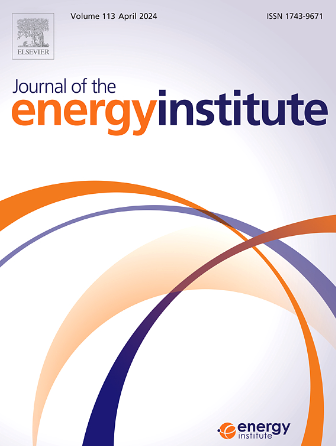木质素催化解聚制备富烃生物油:Ni掺杂对LaCoO3催化剂和氢源的影响
IF 5.6
2区 工程技术
Q2 ENERGY & FUELS
引用次数: 0
摘要
金属和金属氧化物的催化性能对木质素解聚生产酚类和环己烷类化合物至关重要。本研究考察了不同Ni含量LaCoO3钙钛矿催化剂在不同反应温度、时间、催化剂用量等条件下对木质素解聚的影响。此外,还测试了各种氢源,包括甲酸、乙醇和纯氢。在乙醇溶剂下,以氢为溶剂的生物油收率最高(75.3 wt%),但对环己烷和酚类单体化合物的选择性较低。采用甲酸(FA)和7% Ni-LaCoO3催化剂,在280℃条件下,生物油收率为72.4 wt%,对2,6-二甲氧基苯酚(19.5%)、环己烷(18.5%)和甲基环己烷(14.2%)具有较高的选择性。这表明在FA的存在下,Ni能有效地促进木质素β- o (C-O)和β-β (C-C)键的断裂。结果表明,FA反应的0 /C比最低(0.06),H/C比最高(0.14),HHV最高(36.6 MJ/kg)。该催化剂表现出最高的反应速率和加氢活性,这是由于其表面高度分散的Co和Ni的存在。值得注意的是,经过三次回收测试,Ni-LaCoO3催化剂保持了很好的催化活性。这些结果表明,具有这种复合载体的催化剂具有将木质素衍生的酚类化合物转化为更高品位的碳氢化合物液体燃料的潜力。本文章由计算机程序翻译,如有差异,请以英文原文为准。

Catalytic depolymerization of lignin for hydrocarbon rich bio-oil production: Influence of Ni doped on LaCoO3 catalysts and hydrogen sources
The catalytic properties of metals and metal oxides are vital for lignin depolymerization into phenolic and cyclohexane compounds production. This study investigated the lignin depolymerization of with different Ni content LaCoO3 perovskite catalysts at different reaction conditions such as reaction temperature, time, catalysts amount. Furthermore, various hydrogen sources, including formic acid, ethanol, and pure hydrogen were tested. The highest bio-oil yield (75.3 wt%) was achieved with hydrogen under ethanol solvent, but selectivity for cyclohexane and phenolic monomers compound was low. Using formic acid (FA) with 7 % Ni-LaCoO3 catalysts at 280 °C, a bio-oil yield of 72.4 wt% was obtained, with higher selectivity for 2,6-dimethoxyphenol (19.5 %), cyclohexane (18.5 %), and methylcyclohexane (14.2 %). This suggests that Ni with presence of FA facilitates the cleavage of lignin's β-O (C-O) and β-β (C-C) bonds efficiently. The reaction using FA, resulted in the lowest O/C ratio (0.06), highest H/C ratio (0.14), and the highest HHV (36.6 MJ/kg). The catalyst exhibited the highest reaction rate and hydrogenation activity, attributed to the presence of highly dispersed surface Co and Ni species. Notably, after three recycling test, the Ni-LaCoO3 catalyst maintained very good catalytic activity. These results suggest that catalysts with this composite support have the potential to convert lignin-derived phenolic compounds into higher-grade hydrocarbon liquid fuels.
求助全文
通过发布文献求助,成功后即可免费获取论文全文。
去求助
来源期刊

Journal of The Energy Institute
工程技术-能源与燃料
CiteScore
10.60
自引率
5.30%
发文量
166
审稿时长
16 days
期刊介绍:
The Journal of the Energy Institute provides peer reviewed coverage of original high quality research on energy, engineering and technology.The coverage is broad and the main areas of interest include:
Combustion engineering and associated technologies; process heating; power generation; engines and propulsion; emissions and environmental pollution control; clean coal technologies; carbon abatement technologies
Emissions and environmental pollution control; safety and hazards;
Clean coal technologies; carbon abatement technologies, including carbon capture and storage, CCS;
Petroleum engineering and fuel quality, including storage and transport
Alternative energy sources; biomass utilisation and biomass conversion technologies; energy from waste, incineration and recycling
Energy conversion, energy recovery and energy efficiency; space heating, fuel cells, heat pumps and cooling systems
Energy storage
The journal''s coverage reflects changes in energy technology that result from the transition to more efficient energy production and end use together with reduced carbon emission.
 求助内容:
求助内容: 应助结果提醒方式:
应助结果提醒方式:


